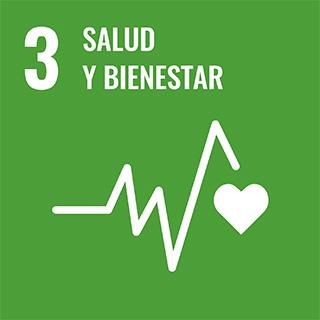
Indexado en
Licencia y uso

Impacto en los Objetivos de Desarrollo Sostenible (ODS)

Análisis de autorías institucional
Gatell JAutor o CoautorRisk for non-AIDS-defining and AIDS-defining cancer of early versus delayed initiation of antiretroviral therapy: A multinational prospective cohort study
Publicado en:Annals Of Internal Medicine. 174 (6): 768-776 - 2021-06-01 174(6), DOI: 10.7326/M20-5226
Autores: Chammartin F; Lodi S; Logan R; Ryom L; Mocroft A; Kirk O; D'Arminio Monforte A; Reiss P; Phillips A; El-Sadr W; Hatleberg CI; Pradier C; Bonnet F; Law M; De Wit S; Sabin C; Lundgren JD; Bucher HC; Calvo G; Dabis F; Morfeldt L; Weber R; Lind-Thomsen A; Salbøl Brandt R; Hillebreght M; Zaheri S; Wit FWNM; Scherrer A; Schoni-Affolter F; Rickenbach M; Tavelli A; Fanti I; Leleux O; Mourali J; Le Marec F; Boerg E; Thulin E; Sundstrom A; Bartsch G; Thompsen G; Necsoi C; Delforge M; Fontas E; Caissotti C; Dollet K; Mateu S; Torres F; Petoumenos K; Blance A; Huang R; Puhr R; Grønborg Laut K; Kristensen D; Kamara DA; Smith CJ; Raben D; Matthews C; Bojesen A; Grevsen AL; Powderly B; Shortman N; Moecklinghoff C; Reilly G; Smit C; Ross M; Fux CA; Morlat P; Friis-Møller N; Kowalska J; Bohlius J; Bower M; Fatkenheuer G; Grulich A; Sjøl A; Meidahl P; Iversen JS; Hillebregt M; Prins JM; Kuijpers TW; Scherpbier HJ; Van Der Meer JTM; Godfried MH; Van Der Poll T; Nellen FJB; Geerlings SE; Van Vugt M; Pajkrt D; Bos JC; Wiersinga WJ; Van Der Valk M; Goorhuis A; Hovius JW; Van Eden J; Henderiks A; Van Hes AMH; Mutschelknauss M; Nobel HE; Pijnappel FJJ; Jurriaans S; Back NKT
Afiliaciones
Resumen
Background: Immediate initiation of antiretroviral therapy (ART) regardless of CD4 cell count reduces risk for AIDS and non-AIDS-related events in asymptomatic, HIV-positive persons and is the standard of care. However, most HIV-positive persons initiate ART when their CD4 count decreases below 500 × 109 cells/L. Consequences of delayed ART on risk for non-AIDS-defining and AIDS-defining cancer, one of the most common reasons for death in HIV, are unclear. Objective: To estimate the long-term risk difference for cancer with the immediate ART strategy. Design: Multinational prospective cohort study. Setting: The D:A:D (Data collection on Adverse events of anti-HIV Drugs) study, which included HIV-positive persons from Europe, Australia, and the United States. Participants: 8318 HIV-positive persons with at least 1 measurement each of CD4 cell count and viral load while ART-naive (study period, 2006 to 2016). Measurements: The parametric g-formula was used, with adjustment for baseline and time-dependent confounders (CD4 cell count and viral load), to assess the 10-year risk for non-AIDS-defining and AIDS-defining cancer of immediate versus deferred (at CD4 counts < 350 and < 500 × 109 cells/L) ART initiation strategies. Results: During 64 021 person-years of follow-up, 231 cases of non-AIDS-defining cancer and 272 of AIDS-defining cancer occurred among HIV-positive persons with a median age of 36 years (interquartile range, 29 to 43 years). With immediate ART, the 10-year risk for non-AIDS-defining cancer was 2.97% (95% CI, 2.37% to 3.50%) and that for AIDS-defining cancer was 2.50% (CI, 2.37% to 3.38%). Compared with immediate ART initiation, the 10-year absolute risk differences when deferring ART to CD4 counts less than 500 × 109 cells/L and less than 350 × 109 cells/L were 0.12 percentage point (CI, -0.01 to 0.26 percentage point) and 0.29 percentage point (CI, -0.03 to 0.73 percentage point), respectively, for non-AIDS-defining cancer and 0.32 percentage point (CI, 0.21 to 0.44 percentage point) and 1.00 percentage point (CI, 0.67 to 1.44 percentage points), respectively, for AIDS-defining cancer. Limitation: Potential residual confounding due to observational study design. Conclusion: In this young cohort, effects of immediate ART on 10-year risk for cancer were small, and further supportive data are needed for non-AIDS-defining cancer. Primary Funding Source: Highly Active Antiretroviral Therapy Oversight Committee.
Palabras clave
Indicios de calidad
Impacto bibliométrico. Análisis de la aportación y canal de difusión
El trabajo ha sido publicado en la revista Annals Of Internal Medicine debido a la progresión y el buen impacto que ha alcanzado en los últimos años, según la agencia WoS (JCR), se ha convertido en una referencia en su campo. En el año de publicación del trabajo, 2021, se encontraba en la posición 6/172, consiguiendo con ello situarse como revista Q1 (Primer Cuartil), en la categoría Medicine, General & Internal. Destacable, igualmente, el hecho de que la Revista está posicionada por encima del Percentil 90.
Desde una perspectiva relativa, y atendiendo al indicador del impacto normalizado calculado a partir de las Citas Mundiales de Scopus Elsevier, arroja un valor para la media Ponderada del Impacto Normalizado de la agencia Scopus: 1.19, lo que indica que, de manera comparada con trabajos en la misma disciplina y en el mismo año de publicación, lo ubica como trabajo citado por encima de la media. (fuente consultada: ESI 14 Nov 2024)
Esta información viene reforzada por otros indicadores del mismo tipo, que aunque dinámicos en el tiempo y dependientes del conjunto de citaciones medias mundiales en el momento de su cálculo, coinciden en posicionar en algún momento al trabajo, entre el 50% más citados dentro de su temática:
- Field Citation Ratio (FCR) de la fuente Dimensions: 3.91 (fuente consultada: Dimensions Jul 2025)
De manera concreta y atendiendo a las diferentes agencias de indexación, el trabajo ha acumulado, hasta la fecha 2025-07-25, el siguiente número de citas:
- Scopus: 16
- Open Alex: 15
Impacto y visibilidad social
Análisis de liderazgo de los autores institucionales
Este trabajo se ha realizado con colaboración internacional, concretamente con investigadores de: Argentina; Australia; Austria; Belgium; Croatia; Czech Republic; Denmark; Estonia; Finland; France; Georgia; Germany; Gran Bretanya; Greece; Hungary; Iceland; Israel; Italy; Jerusalem; Latvia; Lithuania; Luxembourg; Netherlands; Norway; Oman; Poland; Portugal; Russia; Serbia; Slovenia; Sweden; Switzerland; United Kingdom; United States of America.
